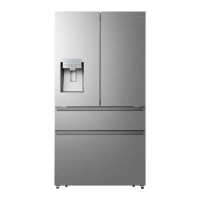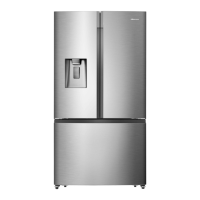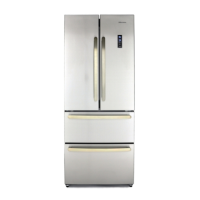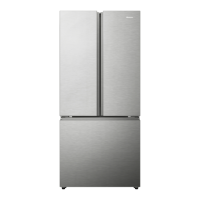Do you have a question about the Hisense RF749N4SWSE and is the answer not in the manual?
General safety and warning messages for safe operation and usage.
Safety precautions for children and vulnerable individuals, including disposal advice.
General safety guidelines for household and similar applications, including warnings.
Details about the refrigerant used, its flammability, and safe handling during disposal.
Safety precautions for electrical connections and the power cord.
Safety measures for daily operation, including appliance usage and storage.
Instructions for safe cleaning of the appliance, including precautions.
Guidelines for location, ventilation, and electrical connections for installation.
Procedures for unpacking, positioning, and leveling the refrigerator.
Steps to align the refrigerator doors to ensure proper sealing and appearance.
Instructions for safely disposing of an old refrigerator to prevent hazards.
Crucial information regarding the safe disposal of refrigerants according to regulations.
Instructions for using and assembling the water dispenser feature.
Guide to operating the appliance using the control panel and its functions.
Explanation of special cooling modes like Super Cool, Super Freeze, and Eco.
Detailed instructions for cleaning the interior, exterior, and door seals.
Information regarding the LED lighting system and contacting technician for issues.
Guidelines for preparing the refrigerator for periods of absence.
Steps for safely moving the refrigerator, including precautions.
Solutions for common problems like the refrigerator not running.
Explanation of normal and abnormal sounds the refrigerator might make.
Solutions for problems related to temperature control and moisture buildup.
Information on recycling packaging materials according to waste regulations.
Proper methods for disposing of the refrigerator as electrical waste.
General safety and warning messages for safe operation and usage.
Safety precautions for children and vulnerable individuals, including disposal advice.
General safety guidelines for household and similar applications, including warnings.
Details about the refrigerant used, its flammability, and safe handling during disposal.
Safety precautions for electrical connections and the power cord.
Safety measures for daily operation, including appliance usage and storage.
Instructions for safe cleaning of the appliance, including precautions.
Guidelines for location, ventilation, and electrical connections for installation.
Procedures for unpacking, positioning, and leveling the refrigerator.
Steps to align the refrigerator doors to ensure proper sealing and appearance.
Instructions for safely disposing of an old refrigerator to prevent hazards.
Crucial information regarding the safe disposal of refrigerants according to regulations.
Instructions for using and assembling the water dispenser feature.
Guide to operating the appliance using the control panel and its functions.
Explanation of special cooling modes like Super Cool, Super Freeze, and Eco.
Detailed instructions for cleaning the interior, exterior, and door seals.
Information regarding the LED lighting system and contacting technician for issues.
Guidelines for preparing the refrigerator for periods of absence.
Steps for safely moving the refrigerator, including precautions.
Solutions for common problems like the refrigerator not running.
Explanation of normal and abnormal sounds the refrigerator might make.
Solutions for problems related to temperature control and moisture buildup.
Information on recycling packaging materials according to waste regulations.
Proper methods for disposing of the refrigerator as electrical waste.
| Lamp type | LED |
|---|---|
| No Frost (fridge) | Yes |
| Fridge net capacity | 367 L |
| Fridge door balconies | 4 |
| Fridge temperature range | 2 - 8 °C |
| Number of vegetable drawers | 2 |
| Fridge number of shelves/baskets | 3 |
| Package depth | 728 mm |
| Package width | 968 mm |
| Package height | 1901 mm |
| Package weight | 134000 g |
| Star rating | 4* |
| Freezer position | Bottom-placed |
| Freezing capacity | 7 kg/24h |
| Freezer net capacity | 212 L |
| Freezer temperature (min) | -24 °C |
| Storage time during power failure | 15 h |
| Control type | Touch |
| Product color | Stainless steel |
| Product design | French door |
| Shelves material | Glass |
| Appliance placement | Freestanding |
| Connected load | 200 W |
| Power plug type | Type G |
| AC input voltage | 220-240~ V |
| Energy efficiency scale | A to G |
| Annual energy consumption | 338 kWh |
| Auto-close system | No |
| Noise level | 39 dB |
| Certification | CE, UKCA |
| Climate class | ST-T |
| Cooling system | Ventilated |
| Water supply type | Water tank |
| Total net capacity | 579 L |
| Minimum operating temperature | 10 °C |
| Convertible compartment temperature range | -18 - 5 °C |
| Convertible compartment number of shelves/baskets | 1 |
| Country of origin | China |
| Depth | 725 mm |
|---|---|
| Width | 914 mm |
| Height | 1785 mm |
| Weight | 120000 g |











